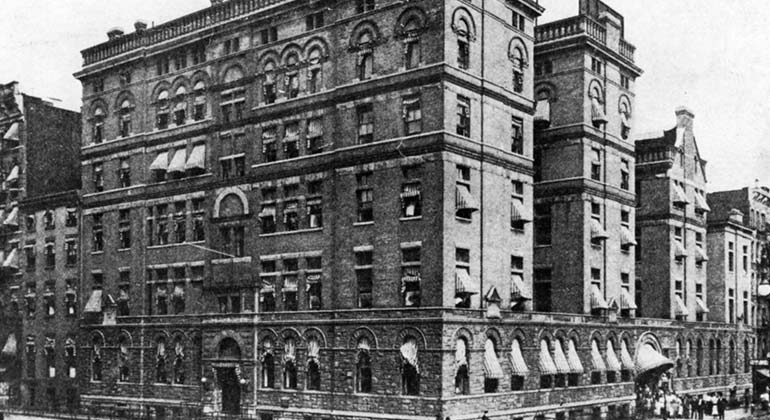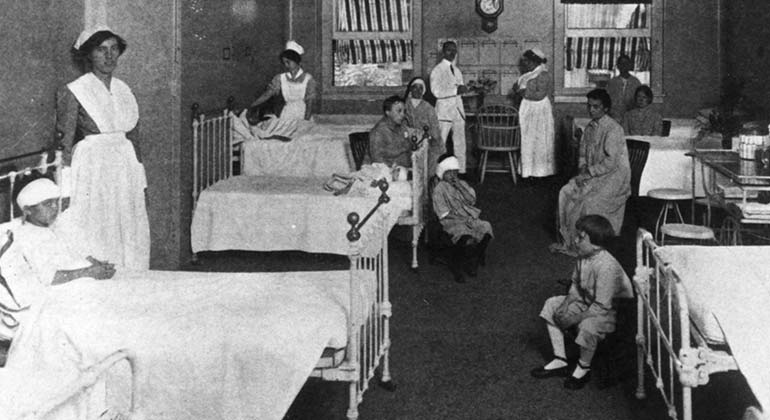
Edward Delafield, MD (Left) and John Kearny Rodgers, MD (Right)

Thirteenth Street & 2nd Ave., 1903

Pediatric Patients Room, 1900s
History and Mission
The origin of New York Eye and Ear Infirmary of Mount Sinai (NYEE) dates to 1816, when two young graduates of the New York College of Physicians and Surgeons, Edward Delafield, a medical resident, and John Kearny Rodgers, a surgical resident, set out from New York to continue their medical training in London. There they met Edward Reynolds, MD, who introduced them to the London Infirmary for Curing Diseases of the Eye, later famed as the Royal London Ophthalmic Hospital (Moorfields). The two Americans enrolled in the ophthalmic training program and studied there for the next two years under the tutelage of Sir William Lawrence, Benjamin Travers, John Richard Farre, and Sir Astely Cooper.
In 1818, Delafield and Rogers returned to New York City, surveyed the incidence of eye disease in the population and concluded that existing facilities were inadequate to manage the volume of indigent patients requiring ophthalmic care. Realizing the lack of interest in their project, they determined to finance their charity personally and on August 14, 1820, the original Infirmary was opened.
The young founders gathered prominent members of the business and medical communities to serve as a Board of Directors, the "Society for the New York Eye Infirmary." From 1821-28, the first President of The New York Eye and Ear Infirmary Board was one of the nation's most respected citizens, Col. William Few, then 72 and a retired banker. In his earlier years Col. Few fought in the Revolutionary War and had the distinction of being a signer of the U.S. Constitution.
Although ears had been treated at The New York Eye and Ear Infirmary since its inception, the institution was originally incorporated under the title of The New York Eye Infirmary on March 22, 1822. In 1864, the otology department was given official recognition and the name was legally changed to The New York Eye and Ear Infirmary. In 1873, the throat department was added.
Although teaching had been conducted at New York Eye and Ear Infirmary from the very beginning, the School of Ophthalmology and Otolaryngology, chartered by the State Legislature, was officially founded in 1890. Thus began the first Otolaryngology resident training program in the United States. At that time, training for ophthalmology and otolaryngology was combined. It was not until 1896 that the services were separated.
Clinical audiology was introduced at New York Eye and Ear Infirmary in 1945 to meet the needs of returning World War II veterans with service-connected hearing deficits. From its informal inception with no professional standards for audiologists and "home spun" testing equipment, the department has evolved into a sophisticated center for the evaluation of hearing, speech and voice disorders, balance, and the facial nerve.
Since its founding, New York Eye and Ear Infirmary has remained at the forefront of its specialty in America. Almost every state in the US, and many foreign countries, are represented in New York Eye and Ear Infirmary's roster of graduates and post-graduate students, many of whom have gone on to illustrious careers.
Histories from Two Different Perspectives
Two dedicated physicians intensively researched the history of New York Eye and Ear Infirmary and of the development of their medical specialties in America, producing the following two papers in their respective fields.
Mission Statement of The New York Eye and Ear Infirmary
New York Eye and Ear Infirmary was established in 1820 to meet the eye care needs of New Yorkers, especially the working poor. In keeping with its heritage, today's New York Eye and Ear Infirmary of Mount Sinai is a voluntary, not-for-profit specialty hospital providing comprehensive outpatient and state-of-the-art medical/surgical care in the disciplines of ophthalmology, otolaryngology/ head and neck surgery, and plastic and reconstructive surgery.
NYEE's outpatient ophthalmology and otolaryngology programs provide primary care and treatment in those specialties for the five boroughs of New York City, with concentrations in the institution's historic Lower East Side patient base, Brooklyn, and Queens. NYEE also serves the regional, national, and international communities with unique tertiary medical/surgical specialty services in our fields of expertise.
Vision Statement of New York Eye and Ear Infirmary
New York Eye and Ear Infirmary will continue to be the preferred provider of safe patient-focused specialty services in the disciplines of ophthalmology, otolaryngology/ head and neck surgery, and plastic and reconstructive surgery, and will continue to be responsive to the needs of patients and physicians.
Value Statements
Patient Care: To provide the highest quality, most technologically advanced and consistent multidisciplinary care in an environment where the safety, dignity, and comfort of each patient are paramount. In delivering patient care, New York Eye and Ear Infirmary will strive to provide an error-free environment.
Community Health: To serve as a community resource through an ongoing series of lectures, seminars, health screenings, and activities for disseminating information to the public.
Medical Education: To develop highly qualified, well-trained physician/surgeons through programs of residency training, post-graduate fellowships, and continuing medical education.
Scientific Research: To pursue programs of applied clinical and basic research, which advance knowledge and treatment within our areas of specialty and to enhance patient care through that scientific advancement.
Staff: To value competence in the abilities of our physicians, employees, and volunteers to serve those entrusted to our care and to provide a professional practice environment.
Fiscal Responsibility: To carry out these activities in a financially responsible manner to ensure New York Eye and Ear Infirmary's continued vitality and viability as a provider of specialty health care services while meeting the needs of the communities it serves.
